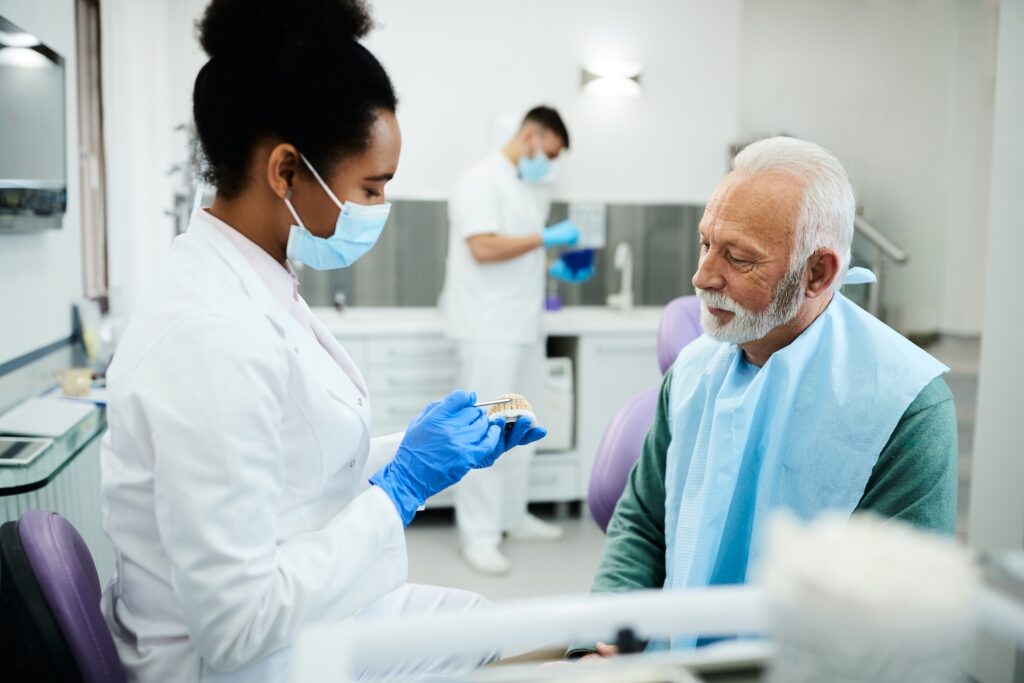Choosing between removable and fixed full arch implant bridges is a big decision. Understanding the differences helps you match treatment to your goals, budget, and lifestyle. At NewStart Denture + Implant Partners, we guide you through each step so your experience is clear, comfortable, and as stress-free as possible. To explore treatment paths and timing, see our dental implant solutions in Raleigh, NC.
What is a full arch dental implant bridge?
A full arch dental implant bridge replaces all the teeth in the upper or lower jaw with a custom bridge that attaches to implants. Instead of resting on the gums like traditional dentures, the bridge is supported by implants placed in the jawbone. In most cases, full arch implants use 4 to 6 implants to support an entire arch of replacement teeth that look and feel closer to natural teeth than removable dentures.
How do they work?
Implants are small posts placed in the jawbone during a minor surgery. The bone heals around them, then a custom bridge is attached. Advanced digital design, CAD/CAM milling, and 3D printing help us plan your bite, smile line, and speech before the final bridge is made.
Who is a good candidate?
Full arch dental implants are recommended for patients with many missing teeth, severely damaged teeth, or long-term denture wearers who want a more secure, implant-supported option. Most patients who choose full arch dental implants are looking for better chewing function, improved speech, and a confident smile.
Understanding fixed full arch implant bridges
Fixed bridges are secured to multiple implants and can only be removed by a dentist. Many fixed bridges are screw-retained to 4 to 6 implants, giving strong support for daily life.
Advantages include excellent stability, high chewing efficiency, and long-term durability.
Considerations include higher cost, more chair time, and more complex surgery, sometimes with bone grafting if bone density is low. Cleaning can be more involved. You will brush under the bridge and around the implants, and many patients add a water flosser for easier hygiene around fixed bridges.
Understanding removable full arch implant-supported dentures
Removable options are sometimes called implant-supported dentures, snap-on dentures, or overdentures. The denture attaches to implants using clips or locator-style attachments. You can take the overdenture out to brush and clean, which keeps food particles from collecting under the prosthesis.
Advantages include easier cleaning, a lower initial cost compared with fixed implant-supported dentures, and less invasive surgery.
Considerations include some movement during biting or speaking, wear of attachment parts over time, and periodic relines or clip replacements. Overdentures can still feel much more secure than complete dentures, but they are not as rigid as fixed bridges.
Key differences between removable and fixed bridges
Stability and function
Fixed full arch dental implants provide the most secure feel, higher bite force, and less movement. Many patients say they can enjoy favorite foods with more confidence. Both fixed and removable options have high implant survival, but fixed designs generally offer stronger function.
Cost of treatment
Fixed bridges usually cost more because they use more implants, more lab steps, and higher-strength materials. Removable options often save money upfront, especially when fewer implants are used.
Maintenance and longevity
Fixed bridges need daily cleaning under the bridge, plus regular professional maintenance. Removable implant-supported dentures are easier to clean and can be very stable. They do need periodic attachment maintenance and occasional relines, since gums can change over time.
With good oral hygiene, the implants that hold either type of bridge can last decades, and even a lifetime.
Patient comfort and lifestyle
Fixed suits patients who want a set-it-and-forget-it feel, strong chewing, and a bridge that stays in place day and night. Removable suits patients who prefer easy cleaning at the sink, want a less complex procedure, or need a budget-friendly path that can potentially be upgraded later. (Note: If you want to leave this option open, discuss it with your dentist before snap-in surgery, so they can incorporate that into their surgery planning.)
Why choose NewStart Denture + Implant Partners
Our team uses advanced digital design, CAD/CAM, and 3D printing to plan dental implants, guide surgery, and craft precise restorations. This improves fit, esthetics, and efficiency from surgery through the final prostheses. We are experts in full-arch implants, implant-supported dentures, and complex dental implant restorations.
We explain every step, from the initial consultation through surgery, temporaries, and final bridges. You see options side by side so you can choose what fits your goals. Our patients report reduced discomfort with eating, clearer speech, and a brighter smile after treatment. See examples of how we help patients regain self-confidence and function.
Frequently asked questions
The implants themselves can last for decades or a lifetime with good oral hygiene, regular checkups, and professional cleanings. Both bridges and overdentures may need maintenance over time, including eventual replacement.
Yes, in some cases. Many patients begin with a removable implant-supported denture, then add implants or convert to a fixed bridge later. This phased approach can spread costs and appointments while improving function now. In the meantime, replacing missing teeth with implants can support bone health and help prevent bone loss around the implant area as you chew.
Sometimes additional implants or implant repositioning are required to move to a fixed bridge, so it is important to discuss a possible transition plan with your dentist from the start. Planning ahead can help you make the best choices for the near future as well as down the road.
Removable implant-supported dentures often use 2 implants in the lower jaw, while the upper may need more for stability. Fixed full arch bridges commonly use four implants or more per arch. The exact number depends on bone quality, anatomy, and your bite.
Removable dentures are a bit easier to clean, but fixed bridges are not hard once you learn the routine. You will brush and use tools made for them, such as floss threaders or a water flosser.
Most patients return to normal activities within a few days after implant surgery. Full healing of the jawbone around implants can take several months. Your specific recovery time depends on factors such as the number of implants placed, whether bone grafting was done, and your overall health.
Removable or fixed full arch implants?
Fixed bridges feel most like natural teeth, with maximum stability and chewing power. Removable options are easier to clean, less invasive, save money upfront, and can leave your options open. Both choices replace an entire arch of missing teeth and can help prevent bone loss and maintain oral health by stimulating the jaw during chewing.
The right option depends on your comfort, budget, and long-term goals for function and aesthetics. If you live in the Raleigh area and are ready to compare full arch dental implants, schedule your consultation at NewStart today.

 Contact Us Today
Contact Us Today
 NewStart Denture & Implant Partners
NewStart Denture & Implant Partners